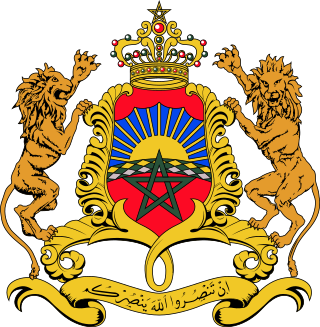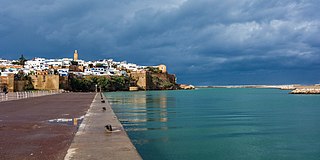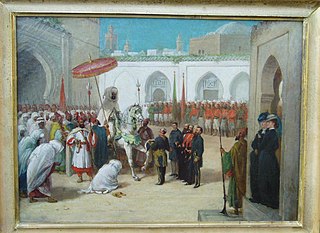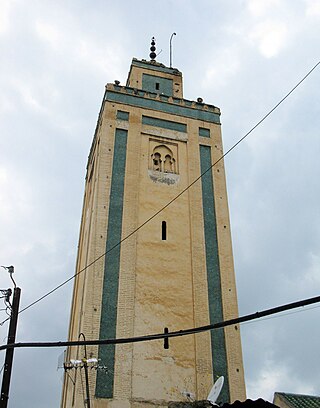
Casablanca, also known by its Arabic name Dar el-Beida, is the largest city in Morocco and the country's economic and business center. Located on the Atlantic coast of the Chaouia plain in the central-western part of Morocco, the city has a population of about 3.71 million in the urban area, and over 4.27 million in the Greater Casablanca, making it the most populous city in the Maghreb region, and the eighth-largest in the Arab world.

Politics of Morocco take place in a framework of an official parliamentary constitutional monarchy, whereby the prime minister of Morocco is the head of government, and of a multi-party system. Executive power is exercised by the government. Legislative power is vested in both the government and the two chambers of parliament, the Assembly of Representatives of Morocco and the Assembly of Councillors. The Moroccan Constitution provides for a monarchy with a Parliament and an independent judiciary.

Rabat is the capital city of Morocco and the country's seventh-largest city with an urban population of approximately 580,000 (2014) and a metropolitan population of over 1.2 million. It is also the capital city of the Rabat-Salé-Kénitra administrative region. Rabat is located on the Atlantic Ocean at the mouth of the river Bou Regreg, opposite Salé, the city's main commuter town.

Ifni was a Spanish province on the Atlantic coast of Morocco, south of Agadir and across from the Canary Islands. It had a total area of 1,502 km2 (580 sq mi), and a population of 51,517 in 1964. The main industry was fishing. The present-day Moroccan province in the same area is called Sidi Ifni, with its capital in the city of the same name, but encompassing a much larger territory.

Mohammed al-Khamis bin Yusef bin Hassan al-Alawi, better known simply Mohammed V, was Sultan of Morocco from 1927 to 1953 and from 1955 to 1957, and King of Morocco from 1957 to 1961. A member of the 'Alawi dynasty, he played an instrumental role in securing the independence of Morocco from France.

Hassan II was King of Morocco from 1961 until his death in 1999.

The 'Alawi dynasty – also rendered in English as Alaouite, 'Alawid, or Alawite – is the current Moroccan royal family and reigning dynasty. They are an Arab sharifian dynasty and claim descent from the Islamic prophet Muhammad through his grandson, Hasan ibn Ali. Their ancestors originally migrated to the Tafilalt region, in present-day Morocco, from Yanbu on the coast of the Hejaz in the 12th or 13th century.

Sidi Ifni is a city located on the west coast of Morocco, on the shores of the Atlantic Ocean, with a population of 20,051 people. The economic base of the city is fishing. It is located in Guelmim-Oued Noun region and Sidi Ifni Province. Its inhabitants are the Shilha from the Ait Baamrane ethnic group. In 2000, an important fishing port was completed, which serves as a base for fish exports.

The Ifni War, sometimes called the Forgotten War in Spain, was a series of armed incursions into Spanish West Africa by Moroccan insurgents that began in October 1957 and culminated with the abortive siege of Sidi Ifni.
Sidi Mohammed ben Abdallahal-Khatib, known as Mohammed III, born in 1710 in Fes and died on 9 April 1790 in Meknes, was the Sultan of Morocco from 1757 to 1790 as a member of the 'Alawi dynasty. He was the governor of Marrakesh around 1750. He was also briefly sultan in 1748. He rebuilt many cities after the earthquake of 1755, including Mogador, Casablanca, and Rabat, and Abdallah Laroui described him as "the architect of modern Morocco." He also defeated the French in the Larache expedition in 1765 and expelled the Portuguese from Mazagan (al-Jadīda) in 1769. He is notable for having been the leader of one of the first nations to recognize American independence in his alliance with Luis de Unzaga 'le Conciliateur' through correspondence and Unzaga's secret intelligence service and led by his brothers-in-law Antonio and Matías de Gálvez from the Canary Islands. He was the son of Mawlay Abdallah bin Ismail and his wife a lady of the Chéraga guich tribe.

MawlayMuhammad bin Abd al-Rahman, known as Muhammad IV, born in Fes in 1803 and died in Marrakesh in 1873, was the Sultan of Morocco from 28 August 1859 to 16 September 1873 as a ruler of the 'Alawi dynasty. He was proclaimed sultan after the death of his father, Abd al-Rahman. His reign marked a series of reform to tackle European influence on Morocco, as Ottoman Algeria had just been conquered by France in 1830, leading to European nations entering military conflicts with Morocco, such as the Battle of Isly with France in 1844 and the Battle of Tetuan with Spain in 1860. He was succeeded by his son Hassan I.

In Morocco, the 75 second-level administrative subdivisions are 13 prefectures and 62 provinces. They are subdivisions of the 12 regions of Morocco. Each prefecture or province is subdivided into arrondissements, municipalities or urban municipalities in other urban areas, and districts in rural areas. The districts are subdivided into rural municipalities. One prefecture (Casablanca) is also subdivided into préfectures d'arrondissements, similar to districts (cercles) except they are grouping a few arrondissements instead of rural municipalities.
Alan Fisher is a Scottish broadcast journalist and war correspondent.
Casa Air Service was a Moroccan airline. In 1995 it began to offer private air transport services. For 40 years prior to that, it was involved in agricultural air services.

The Moroccan protests are a series of demonstrations across Morocco which occurred from 20 February 2011 to the fall of 2012. They were part of the larger Arab Spring protests. The protests were organized by the 20 February Movement.
Princess Lalla Amina was a member of the Moroccan royal family and former President of the Royal Moroccan Federation of Equestrian Sports.

The Kingdom of Morocco and the State of Qatar formed diplomatic relations in 1972. There is substantial economic cooperation between the two countries, with Qatar being one of the largest foreign investors in Morocco. A $2 billion joint venture between Qatar's sovereign wealth fund and Morocco was established in 2011.
Rachidi is a surname. Notable people with the name include:

The Moulay Abdallah Mosque or Mosque of Moulay Abdallah is a major mosque and royal necropolis complex situated in the center of the Moulay Abdallah district in Fes el-Jdid, the historic palace-city and citadel in Fes, Morocco. It was founded by the Alaouite sultan Moulay Abdallah who is buried in the adjoining necropolis along with later members of the dynasty.












